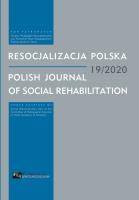Compulsory commitment of inmates into the restrictive housing in U.S. prisons – roles, goals and future dynamics
Compulsory commitment of inmates into the restrictive housing in U.S. prisons – roles, goals and future dynamics
Author(s): Małgorzata SzwejkowskaSubject(s): Penology
Published by: Fundacja Pedagogium
Keywords: inmate; U.S. correctional system;prison; restrictive housing;correctional regulations and policies
Summary/Abstract: Compulsory commitment of inmates into restrictive housing, or so called solitaryconfinement, administrative segregation, supermax, gives rise to many controversial issues that scientific research in the United States deals with. Subject to discussion are especially the constitutional controversies and the influence of such a treatment on the offender’s wellbeingas a human that tends to maintain social contact and that is vulnerable to possible negative impact of such strict conditions. Among scholars and practitioners there are opponents and also supporters of this solution, although internationally there is a conclusion (see the NelsonMandela Rules) that restrictive housing should be banned, in particular when it is imposedon inmates for an indeterminate period or a prolonged period of time. Nowadays, the prevalentopinion is that other policies and practices should be worked out and implemented in order to replace restrictive housing, and at the same time that tools will have to be able toassist in achieving the main goals: security and order in the prison as well as rehabilitation and deterrent impact on inmates.
Journal: Resocjalizacja Polska
- Issue Year: 19/2020
- Issue No: 1
- Page Range: 89-102
- Page Count: 14
- Language: English

